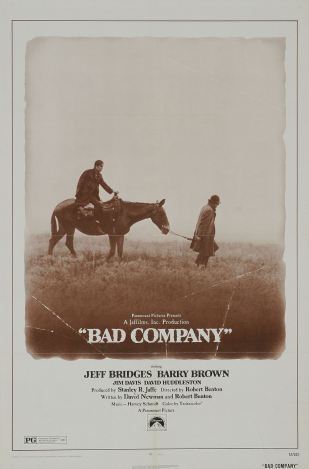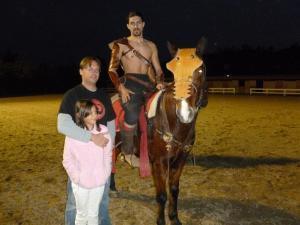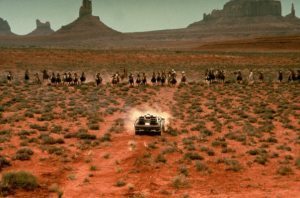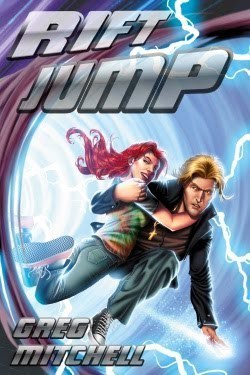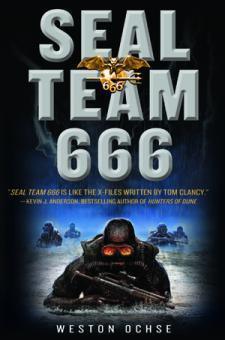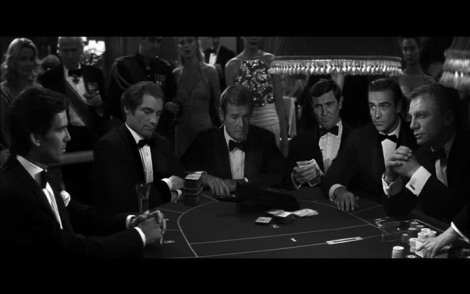Edward M. Erdelac's Blog, page 31
January 14, 2013
DT Moviehouse Review: Bad Company
Time once more for my blog feature, DT Moviehouse Reviews, in which I make my way alphabetically through my 200+ DVD/Blu-Ray collection (you can see the list right here) and decide if each one was worth the money. Appropriately enough for the first movie review of the new year, I take a look at the first western of the list, Bad Company.
(1972) Directed By Robert Benton
Screenply by Robert Benton and David Newman
Tagline: They’re young, desperate, dangerous….a long way from home, but a short way from hell.
What It’s About:
During the American Civil War, young Drew Dixon (Barry Brown) flees home with a hundred dollars and heads to the western frontier to avoid conscription in the Union Army. He winds up falling in with a group of like minded orphans led by charming and swift talking young con man Jake Rumsey (Jeff Bridges). Drew cons the ‘gang’ into thinking he robbed a hardware store and dips into his money to outfit them all with horses and supplies for their joint excursion. Times are hard, and after being robbed by a band of outlaws, the boys turn to crime themselves to survive, schooling each other on honesty and loyalty along the trail.
Why I Bought It:
I’m a big fan of Jeff Bridges and the so-called revisionist or acid westerns of the 1960′s and 70′s (like Pat Garrett And Billy The Kid, The Hired Hand, and Dirty Little Billy), and actually bought this movie sight unseen after seeing a couple stills and reading a synopsis. This gambit almost never plays out for me, but this time it did.
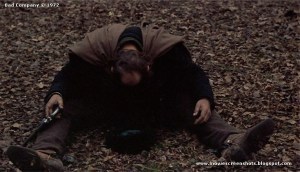 The movie is very minimalist, with an almost cinema verite approach (in the same vein as The Culpepper Cattle Company and The Ballad Of Gregorio Cortez – see my post The Reel Real West – Seven Gritty Westerns You’ve Never Seen). It’s very diffuse, almost sepia toned like an old photograph, and everything, the acting, the admittedly meandering plot, and the sudden and extreme violence, is very realistic.
The movie is very minimalist, with an almost cinema verite approach (in the same vein as The Culpepper Cattle Company and The Ballad Of Gregorio Cortez – see my post The Reel Real West – Seven Gritty Westerns You’ve Never Seen). It’s very diffuse, almost sepia toned like an old photograph, and everything, the acting, the admittedly meandering plot, and the sudden and extreme violence, is very realistic.
There is a scene I love where the boys surprise a rabbit on the prairie and all open fire on it. After running through a virtual firing squad of misses, one of the bullets finally blows the rabbit open, and when Jake commands the youngest of their number to skin the animal, he quickly finds out to his vociferous exasperation that none of them knows how to clean a carcass. He proceeds to show them, and from his readily apparent disgust, it seems he hasn’t ever done it either. Although the skinning of the rabbit is just offscreen, I can’t believe by Bridges’ reactions that he’s not actually cleaning the kill. He’s too young an actor at that point to be able to portray honest revulsion so well.
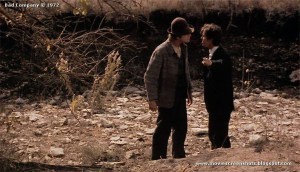 The interactions between Brown and Bridges are the highpoint of the movie, with Brown a pampered, well educated, cowardly hypocrite, espousing high virtues at every turn (refusing to actually rob a store, refusing to avail himself of the services of a prostitute etc) and yet every bit the con man Bridges’ character is, and plainly less honest (maybe even, for all Jake’s worldly bluster, a little less naive) and loyal.
The interactions between Brown and Bridges are the highpoint of the movie, with Brown a pampered, well educated, cowardly hypocrite, espousing high virtues at every turn (refusing to actually rob a store, refusing to avail himself of the services of a prostitute etc) and yet every bit the con man Bridges’ character is, and plainly less honest (maybe even, for all Jake’s worldly bluster, a little less naive) and loyal. 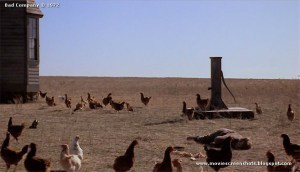 The movie is a morality tale of sorts, about going bad and yet also about retaining personal honor. Brown’s character allows the rest of the gang to go hungry even though he has nearly a hundred dollars hidden in his shoe the entire time. At one point this actually costs one of the boys’ their lives when they try to snatch a cooling pie off the sill of an open window and the resident shoots them dead.
The movie is a morality tale of sorts, about going bad and yet also about retaining personal honor. Brown’s character allows the rest of the gang to go hungry even though he has nearly a hundred dollars hidden in his shoe the entire time. At one point this actually costs one of the boys’ their lives when they try to snatch a cooling pie off the sill of an open window and the resident shoots them dead.
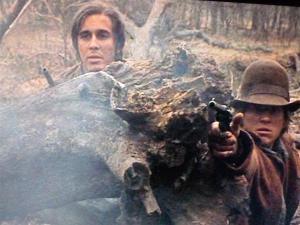 Young Joshua Hill Lewis does a good job as Boog, the aforementioned boy. There’s a scene where Brown is reading Jane Eyre to the gang and Boog interrupts with a breathless story about his murdered father that plays very nicely.
Young Joshua Hill Lewis does a good job as Boog, the aforementioned boy. There’s a scene where Brown is reading Jane Eyre to the gang and Boog interrupts with a breathless story about his murdered father that plays very nicely.
The movie has a host of familiar faces in great ‘character’ roles. David Huddleston is excellent as outlaw chief Big Joe as are Geoffrey Lewis and John Quade as raggedy gunmen. John Savage plays one of the gang, and Jim Davis (a Republic western veteran who appears in my all time favorite Kung Fu episode, The Soul Is The Warrior) is a severe, authoritarian marshal.
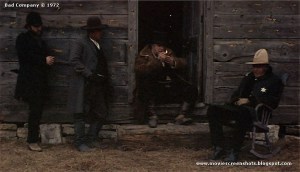 As a western nerd, there are some anachronisms I feel the need to point out. If it’s the 1860′s during the Civil War, it’s maybe eight or ten years before cartridge ammunition and revolvers, but they’re prevalently used here. In a great scene after the capture of Big Joe, the lawmen ask him to demonstrate the ‘Curly Bill Spin,’ a gun trick which he claims to have taught to Curly Bill personally. The Curly Bill Spin (variations of it are shown in Tombstone, Wyatt Earp, Young Guns, and The Outlaw Josey Wales) was when you passed your gun to a man butt first but kept your finger in the trigger guard so as the man reached for it, you flipped it up (or spun it up) into your palm, cocking the hammer and gaining a surprise advantage. It was once known as the Road Agent Spin or Border Roll, but Curly Bill’s name got attached to it because he supposedly employed it to gun down Tombstone Town Marshal Fred White in 1880. Again, nearly two decades after Bad Company would’ve taken place.
As a western nerd, there are some anachronisms I feel the need to point out. If it’s the 1860′s during the Civil War, it’s maybe eight or ten years before cartridge ammunition and revolvers, but they’re prevalently used here. In a great scene after the capture of Big Joe, the lawmen ask him to demonstrate the ‘Curly Bill Spin,’ a gun trick which he claims to have taught to Curly Bill personally. The Curly Bill Spin (variations of it are shown in Tombstone, Wyatt Earp, Young Guns, and The Outlaw Josey Wales) was when you passed your gun to a man butt first but kept your finger in the trigger guard so as the man reached for it, you flipped it up (or spun it up) into your palm, cocking the hammer and gaining a surprise advantage. It was once known as the Road Agent Spin or Border Roll, but Curly Bill’s name got attached to it because he supposedly employed it to gun down Tombstone Town Marshal Fred White in 1880. Again, nearly two decades after Bad Company would’ve taken place.
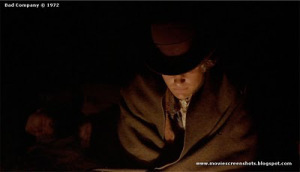 Paul Rodgers of the band Bad Company did not take its name from this movie as I had always heard, but their hit song does (“rebel souls, deserters we are called, chose a gun, and threw away the sun”), and actually shares the introductory three chords with the movie’s score.
Paul Rodgers of the band Bad Company did not take its name from this movie as I had always heard, but their hit song does (“rebel souls, deserters we are called, chose a gun, and threw away the sun”), and actually shares the introductory three chords with the movie’s score.
The movie ends somewhat abruptly, but it’s a great character piece and a fine study on the harsh realities of the outlaw trail and making a living as a scavenger and badman.
Best bit of Dialogue: (Drew, writing home to his family) I shot and ate a skunk today. Taste didn’t enter much into it.
Best Scene: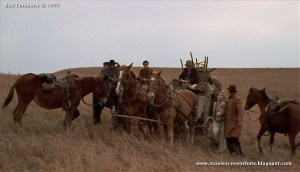 The wild and clumsy shootout and the character revelations concerning Drew’s watch are pretty great, but the scene that sticks out in my mind is when the boys encounter a broken down farmer and his wife headed back east with a wagonload of possessions. The farmer tries to warn the boys that there’s nothing but trials and tribulations on the frontier, and winds up offering to let them have sex with his wife for ten dollars. Jake readily accepts and helps the woman down, walking off with her arm in arm into the grass as the husband rolls a cigarette and the other boys argue about what order they will follow Jake in. Not ten seconds pass when Jake lets out a boisterous crowing and a yahoo and comes stiff-walking quickly back, a huge grin on his face, fastening his belt.
The wild and clumsy shootout and the character revelations concerning Drew’s watch are pretty great, but the scene that sticks out in my mind is when the boys encounter a broken down farmer and his wife headed back east with a wagonload of possessions. The farmer tries to warn the boys that there’s nothing but trials and tribulations on the frontier, and winds up offering to let them have sex with his wife for ten dollars. Jake readily accepts and helps the woman down, walking off with her arm in arm into the grass as the husband rolls a cigarette and the other boys argue about what order they will follow Jake in. Not ten seconds pass when Jake lets out a boisterous crowing and a yahoo and comes stiff-walking quickly back, a huge grin on his face, fastening his belt.
He climbs into the saddle of his horse and declares -
 JAKE: THAT was a deal!
JAKE: THAT was a deal!
The bewildered farmer, who hasn’t even lit his cigarette yet, stares open mouthed as Jake mounts.
FARMER: Are you done already?
JAKE: I do not waste my time, mister. After that ride I gave her, I expect she’ll be too tuckered out for the rest of you boys.
The goofy expression of pride and self satisfaction on Bridges’ face is just priceless. Funny, and at the same time, in the context of the scene with the farmer’s initial warnings, heartbreakingly naive and portentious.
Would I Buy It Again: Yes. Great movie.
Up Next In The Queue: The Beast Must Die


January 11, 2013
My urban horror novella Gully Gods gets a nice mention at SFFWorld Review’s 2012 Retrospective
A while back I put out a dark gangsta horror novella called Gully Gods in a collection called FOUR IN THE MORNING along with fellow authors Tim Marquitz, Lincoln Crisler, and Malon Edwards.
It’s about a young gangbanger named J-Hoss who flees South Houston to lay low with his aunt in Chicago and gets mixed up with an ambitious and violent clique of Liberian ex-child soldiers led by a sadistic murderer called Kid Hitler, who draws strange powers from a dark and terrible deity.
You can read more about it, and an excerpt - here.
Anyway over at SFFWorld, reviewer Nila White wrote a nice mention of FOUR IN THE MORNING, including a well deserved mention of my friend Malon Edward’s FAN-tastic steampunk novella Half-Dark.
http://www.sffworld.com/mul/334p0.html
The bit about me (of which I’m quite proud) reads -
“The second story offered is Gully Gods by Edward M. Erdelac, an urban fantasy that was bone-chilling scary to me, but touched on so many modern issues that this might end up being taught in literature classes some day.”
Thanks to Nila (N.E.) White over at SFFWorld Reviews.
FOUR IN THE MORNING is still available on Amazon, and 100% of any proceeds I get I donate to one of the various charities listed in the book, so check it out (and these worthy causes) -
http://childsoldiersinitiative.org
The United States has its own child soldier dilemma, and it doesn’t gain much sympathy from the public. There are a few organizations out there that work with lower income communities and troubled youth in danger of becoming victims of the pervading gang culture. An internet search will turn up any number in your own area. All of them are in dire need of support.
(LA-based organization that exclusively trains and employs ex-gang members and at-risk youth. ‘Nothing stops a bullet like a job.’ Homeboy is currently on the rocks and could definitely use some help.)
http://www.catholiccharitiesusa.org
http://www.resurrectionproject.org
(works to improve the historic Pilsen neighborhood of Chicago with affordable housing, childcare, and community outreach programs)


January 5, 2013
Among The Mounds: Cahokia
 Happy New Year, all and sundry.
Happy New Year, all and sundry.
First blog post of the year after a long long hiatus deep in the land of frost and dial up internet. Not gonna post New Year’s resolutions or manifestos for my first writing of 2013. I’ll be doing the same thing I do every year. Putting out books and stories for you to read. Plenty of time for all that later.
During my holiday stay in Indiana with the family, we drove my son back and forth from college in St. Louis and while we were there, I took the opportunity to drag my wife to Cahokia Mounds, a state park about seven miles out of the city and a location I’ve been wanting to see for a long time.
It amazes me almost nobody knows about Cahokia. It’s North America’s first bona fide urban center, a metropolis and trading center whose cultural and economic influence extended into Canada and the Southwest according to archaeological evidence.
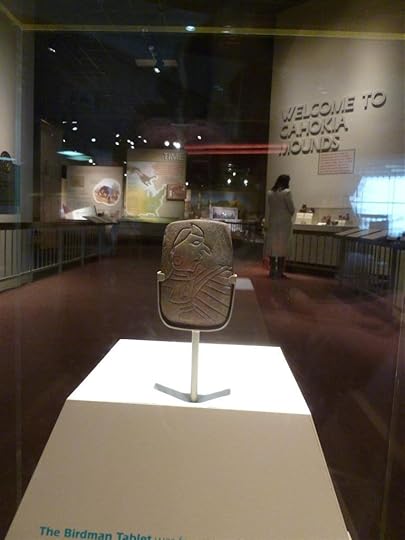 Of course, Cahokia isn’t the original name. Nobody knows what that is as the Mississippiean inhabitants had no alphabet and left no written record. But it was settled around 6oo BC (or CE, if you’re new school), about 500 years before a European contact and at its height supported a popuation of around 20,000 people, through farming, hunting in the winter months, and river trade.
Of course, Cahokia isn’t the original name. Nobody knows what that is as the Mississippiean inhabitants had no alphabet and left no written record. But it was settled around 6oo BC (or CE, if you’re new school), about 500 years before a European contact and at its height supported a popuation of around 20,000 people, through farming, hunting in the winter months, and river trade.
Cahokia consisted of a hundred and twenty earthen mounds constructed over decades, including the enormous Monk’s Mound, a ten story (900 ft) pallisaded pyramidal flat top mound which was capped by the ruler’s temple dwelling, an impressive 50 ft tall thatched rooft structure. Monk’s Mound (named for a group of Trappist monks who settled near there in 1809) is actually the largest prehistoric earthen structure north of Mexico.
Monk’s Mound is still there today and can be ascended by a flight of modern day stairs placed in the same general position as the original wood staircase.
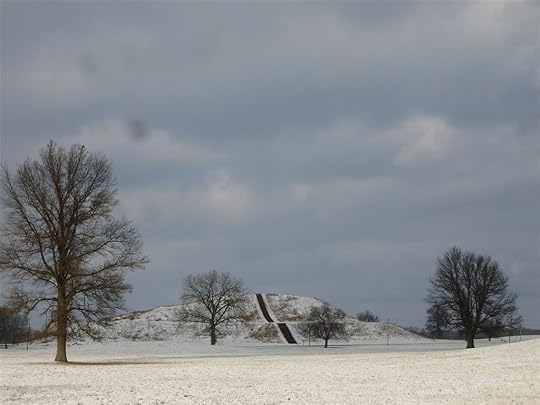
Monk’s Mound in winter
It was a snowy December day a week after the solstice when we visited the cultural center and climbed up Monk’s Mound. You’re buffeted by the wind at the top, and you can see the site in its entirety, and the St. Louis arch as well. A modern road cuts right through the center of the city at the base of Monk’s Mound, destroying what was once an immense hard packed plaza on which were held massive annual games, chunkey (a hugely popular gambling game in which athletes flung spears at a rolling discoidal stone, betting on who could get it closest) and the equivalents of lacrosse, mainly.
 French missionaries built a chapel for the Illiniwek Indians on a corner of the first terrace in the 1700′s, and a man named Amos T. Well once built a house on the very top, but no remnants of either structure remain. Whether they were carted off or blown away as my wife suggests, I have no idea.
French missionaries built a chapel for the Illiniwek Indians on a corner of the first terrace in the 1700′s, and a man named Amos T. Well once built a house on the very top, but no remnants of either structure remain. Whether they were carted off or blown away as my wife suggests, I have no idea.

Woodhenge: Where the demons dwell. Where the banshees live and they do live well
I mentioned the solstice above. Had we visited a week earlier we might’ve seen the annual solstice ceremony traditionally conducted a little bit west of the mound, where the city’s woodhenge has been reconstructed. Woodhenge is just what it sounds like, a prehistoric solar calendar constructed of standing wood poles, same as England’s Stonehenge. It’s situated in such a way that when the sun rises to the east, it peaks right over Monk’s Mound. Scholars posit that this was a way for the ancient rulers to tie their authority to the supreme authority of the sun itself. I walked out to the center pole and found browning rose petals in the snow at the base, remnants of the previous week’s festivities.

Mound 72
Also of interest to me was the infamous and yet innocuously named Mound 72. Not all of the mounds have been excavated, but Mound 72 was. It sits on the southern edge of the site near the tree line, and could easily be mistaken for a low natural hill in the shadow of the massive Monk’s Mound, or the nearby Twin Mounds.

The worm that et of a king? In the midst of death, life
But a mound it is, ridgebacked, and easily ascendable. You could picnic on top of it. Yet beneath it, over 250 skeletons were discovered, the majority of them sacrificial victims. At various layers, Mound 72 contained the bodies of 50 women with their heads bashed in, 40 men and women who had been interred alive (as evidenced by the position of their skeletons, clawing through the earth before they expired), four males, their arms interlocked, missing their hands and heads, and a regally dressed man lain in a grave atop a bed of 20,000 sea shells arranged in the shape of a falcon, a revered mythical figure in ancient Mississppean religion. A kind of charnal hut once stood alongside the mound, perhaps a priestly hut intended for the preparation of occupants, maybe a kill house, or who knows what. The purpose of Mound 72 and the reasons for its various inhabitants’ burials can only be surmised (my own weird suspicions will of course be made known once the story I wrote against the Cahokia backdrop sees print), but one gets an odd sensation standing alone at such a site, with only the snow hissing off the clacking tree branches.
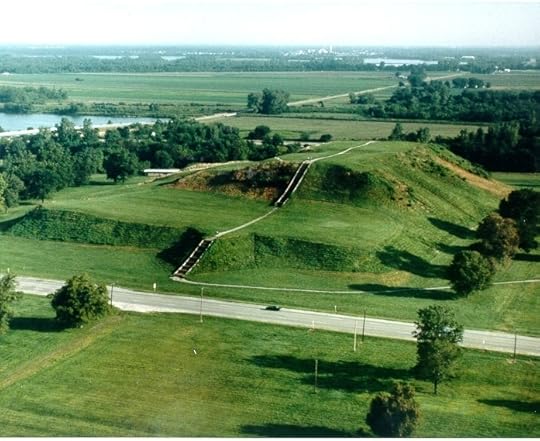
Cahokia in the summer, from the air
What became of Cahokia is a subject for debate too. Maybe the people lost faith in their rulers and dispersed, maybe ill fortuned climate changes or sickness derived from overpopulation and dwindling resources led to its dispersal. I think it was a combination of the latter two which probably led to the former. Maybe it had to do with things that went on at Mound 72.

The Twins, thought to have once been connected by a bridge
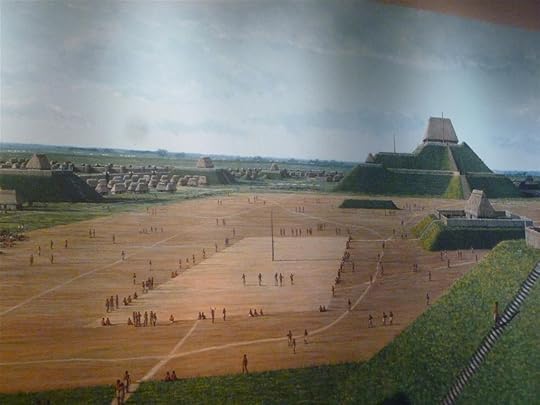
Cahokia in it’s heyday (artist’s impression)
In the summer months the mounds are covered in green grass. From pictures it almost seems like the inhabitants could be cavorting just over the next earthworks. We saw them blanketed in frozen white, leaving one with the impression that the past was dead and dreamless.
But it’s an impressive site. And an impressive sight, well maintained by a friendly and knowledgeable staff. A nice excursion for those histroically or weirdly inclined.
Driving out away my wife and I started speculating about every low hill we saw. The St. Louis area is not naturally hilly. Proceeding through Collinsville we actually saw one fenced off vacant lot that consisted of nothing but a single large mound, apparently recognized and rescued by the scientific community. It was situated between a trailer park and an auto body shop. Wish I’d been able to snap a picture of that one, but we were in a moving vehicle.
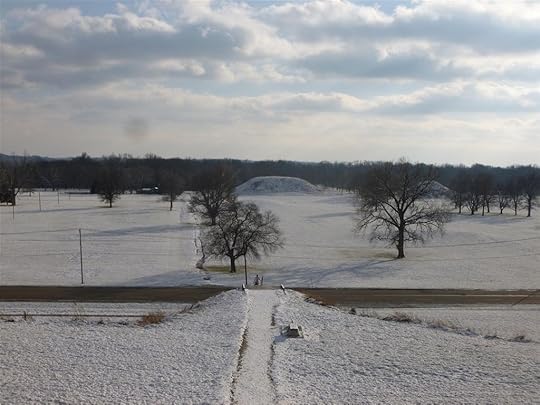
On the summit of Monk’s Mound
The visit drove our imaginations in all directions. By the time we hit the interstate we were seeing mounds everywhere.
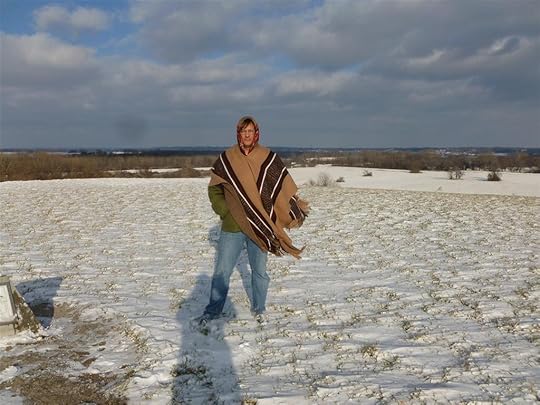
The author on Monk’s Mound (underdressed)
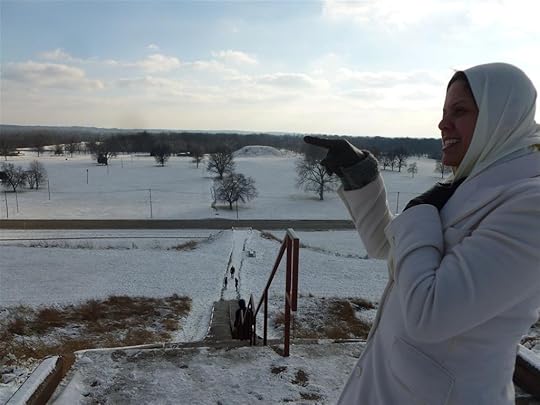
My wife points out our car
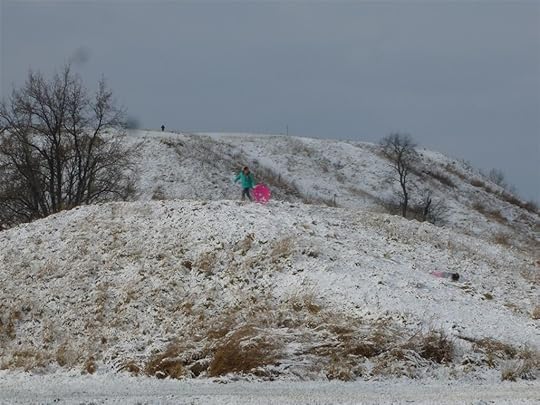
Kids sledding down a mound.


December 16, 2012
Bread And Circuses For The SPOLA (Senate and The People of L.A.)
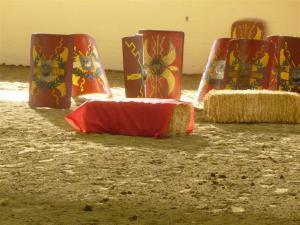 So tonight I took my daughter to see Spartacus And The Roman Legion, a live gladiatorial pageant put on at the LA Equestrian Center’s Equidome by a French historical reenactment group called Heroes Of Antiquity and a company called Histor’Event (and assisted by some American re-enactment clubs).
So tonight I took my daughter to see Spartacus And The Roman Legion, a live gladiatorial pageant put on at the LA Equestrian Center’s Equidome by a French historical reenactment group called Heroes Of Antiquity and a company called Histor’Event (and assisted by some American re-enactment clubs).
Saw the offer via an email from Groupon and jumped at the chance to see guys in Roman cuirasses and half armor duking it out on the sand. I’m a sucker for sword and sandal stuff, from Ben Hur to HBO’s Rome. My daughter wanted to see the cavalry horses.
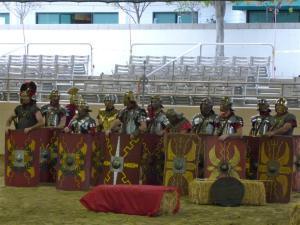 Though Groupon advertised chariots and sixty combatants, I counted about thirty, representing Thracians (though they looked a bit more Celtish/Gaulish to me) and Roman legionnaires. No chariots either, just two horses. This might’ve been a miscommunication between the performers and Groupon however, as the two people taking tickets at the door had no idea what I was talking about when I sheepishly told them I hadn’t thought to print out my confirmation email since Groupon had said I could just show up with photo ID.
Though Groupon advertised chariots and sixty combatants, I counted about thirty, representing Thracians (though they looked a bit more Celtish/Gaulish to me) and Roman legionnaires. No chariots either, just two horses. This might’ve been a miscommunication between the performers and Groupon however, as the two people taking tickets at the door had no idea what I was talking about when I sheepishly told them I hadn’t thought to print out my confirmation email since Groupon had said I could just show up with photo ID.
Whatever, though.
This is not to knock the show. It was still a one of a kind experience. Here in America we have Civil War, Medieval Times, SA Cowboy, and World War II re-enactments (even a few Revolutionary Era) by the dozen. How often do you get to see Roman soldiers and gladiators clash?
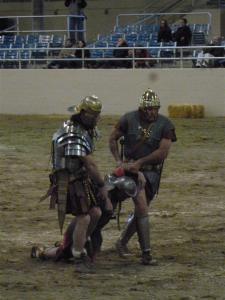 I’m a huge fan of history as any of my readers know, and I’ve been mulling around a story centering on gladiators and ancient Rome for about a year and a half now, so as I said, I leapt at the chance to see re-enactors in action. There’s something about watching the stuff actually being used that you don’t get from watching movies or reading histories. The clatter and clank of the armor, the swords on the shields, way people move and react. The gear was pretty authentic as you can see by the photos.
I’m a huge fan of history as any of my readers know, and I’ve been mulling around a story centering on gladiators and ancient Rome for about a year and a half now, so as I said, I leapt at the chance to see re-enactors in action. There’s something about watching the stuff actually being used that you don’t get from watching movies or reading histories. The clatter and clank of the armor, the swords on the shields, way people move and react. The gear was pretty authentic as you can see by the photos.
The first half of the show was a sort of pageant or play loosely retelling the history of the actual Spartacus (one of my favorite historical personages), from his capture and enslavement in Thrace, through his insurrection, and at last to his final battle. After the death of Spartacus and his followers at the hands of Crassus’ legion, a guy dressed as Charon came out and ushered the slain to the Underworld. Spartacus refused to go, and so was cursed to return two hundred years later during the reign of Commodus as a gladiator once more. The segue to the second half was admittedly a bit goofy, but it was in the tradition of Roman entertainment and I was willing to go with it.
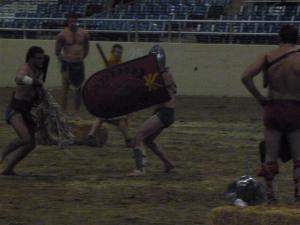 Now at this point let me say that the sun had gone down (this being an hour and a half program), and the temperature in the Griffith Park foothills had definitely dropped to the high thirties. The Equidome is covered, but open air, so it was C-O-L-D in them thar hills. And these guys were dressed in period, meaning little more than loincloths for the gladiators.
Now at this point let me say that the sun had gone down (this being an hour and a half program), and the temperature in the Griffith Park foothills had definitely dropped to the high thirties. The Equidome is covered, but open air, so it was C-O-L-D in them thar hills. And these guys were dressed in period, meaning little more than loincloths for the gladiators.
Now when the guy playing Spartacus was killed and condemned to sleep for two hundred years, he was laid out in the sand and covered with a sheet (and I mean of pillowcase consistency) while everybody else left the field. What followed was a fifteen minute (more like twenty) intermission while people got up to use the bathroom and grab tacos and soda.
In the meantime, Spartacus remained on the field.
My buddy took my daughter to the concession stand and I sat there watching this guy laying in the center of the damp sand, in a loincloth, under a thin sheet.
Now the writer/romantic/what-have-you is gonna come out and say that my thoughts sort of went to the historical Spartacus, how little was actually known about this guy who had broken free of slavery and used the skills taught to him by his masters to cause all of Rome to quake. After Spartacus and his fellow gladiators escaped their school at Capua, he turned his men into an army and raided Roman country homes, freeing slaves wherever he found them, arming them, and thus swelling his own ranks, until the Senate itself was convening specifically to discuss how to deal with him, fearing he would set his sights on Rome itself. It’s really an inspirational story (and actually did inspire the abolitionist John Brown to attempt a similar feat in the 1850’s against the African chattel slavery institution), and a testament to the kind of strength an individual can summon, such that his name lives on centuries after even the grandchildren of anyone who actually ever knew him have turned to dust.
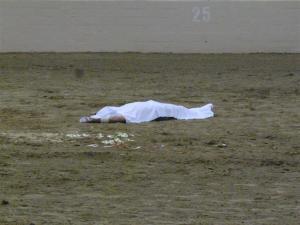
Spartacus at rest
I don’t know if the guy portraying Spartacus has as high an opinion of his alter-ego, but I got the feeling he did, because he lay there in exactly the same posture (in thirty degree weather in a loincloth, I remind you), unmoving, for the entire intermission.
That took dedication.
You will never catch me playing the asshole American card and denigrating the guts of a Frenchman ever again, that I swear.
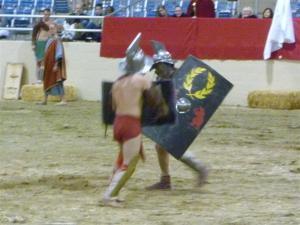 The second half of the show was much more enjoyable. The announcer claimed the outcomes of the subsequent combats were not predetermined, and I can believe it, since Spartacus, outfitted in my favorite gladiator gear, that of the trident and net (or retiarius) wound up losing to a Thracian gladiator. Audience participation was encouraged. Before hand we were given tissues, and after each combat were instructed in the traditional ‘live or die’ signals (waving the tissue called for the loser to be spared, whereas a sort of knife hand gesture meant death) to influence the decision of Emperor Commodus (seated in a canopied area of the arena).
The second half of the show was much more enjoyable. The announcer claimed the outcomes of the subsequent combats were not predetermined, and I can believe it, since Spartacus, outfitted in my favorite gladiator gear, that of the trident and net (or retiarius) wound up losing to a Thracian gladiator. Audience participation was encouraged. Before hand we were given tissues, and after each combat were instructed in the traditional ‘live or die’ signals (waving the tissue called for the loser to be spared, whereas a sort of knife hand gesture meant death) to influence the decision of Emperor Commodus (seated in a canopied area of the arena).
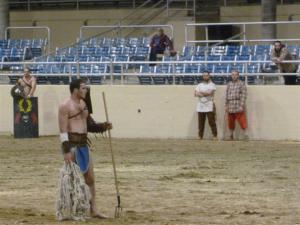 I have read that the horse duel (said to be between two young men from disapproving, wealthy families) with spears was choreographed, but when the weapons and shields were ditched it became a sort of galloping bare knuckle brawl, with each man trying to wrestle the other from the saddle, and looked pretty dang dangerous for horse and rider alike. If it was staged, it was very well done.
I have read that the horse duel (said to be between two young men from disapproving, wealthy families) with spears was choreographed, but when the weapons and shields were ditched it became a sort of galloping bare knuckle brawl, with each man trying to wrestle the other from the saddle, and looked pretty dang dangerous for horse and rider alike. If it was staged, it was very well done.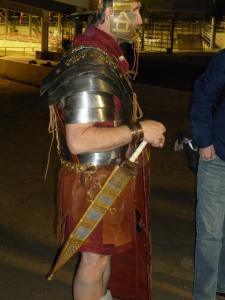
After the show, the participants were good enough to stick around and take pictures with all and sundry, so I and my buddy snapped a few, including one of my daughter and Charon and a lady legionnaire that just impressed the hell out of her (and let her hold her gladius, which to Nolie, was a delight).
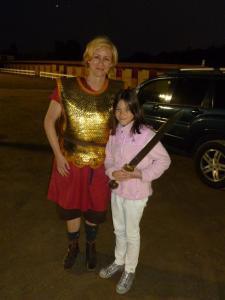 All in all, it was a fun spectacle. The first half is just a bit disorganized, but for me, it was worth it to see these professionals in action. These weren’t pudgy goat-bearded history buffs imitating Rebel yells and burning through Pyrite (and don’t get me wrong, I like watching those guys too), but real athletes, diving from horseback (and riding hands free), flipping over each other, rolling under sword swings, smashing shields together, and appearing to have a heck of a good time.
All in all, it was a fun spectacle. The first half is just a bit disorganized, but for me, it was worth it to see these professionals in action. These weren’t pudgy goat-bearded history buffs imitating Rebel yells and burning through Pyrite (and don’t get me wrong, I like watching those guys too), but real athletes, diving from horseback (and riding hands free), flipping over each other, rolling under sword swings, smashing shields together, and appearing to have a heck of a good time.
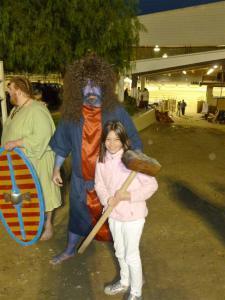
Nolie rubbing elbows with Charon
I read a bit on the troupe that put the show together (here), and apparently they have a large scale to do annually in Nimes, France, where they also maintain a modern day gladiator school. I believe this was their first American outing (and understandably smaller in scope). Attendance Saturday night was admittedly pretty sparse, so if you’re in the LA area, I urge you to attend the Sunday performance.
Give these guys a reason to come back to the USA, cause next time it’ll be a bigger show and it’s better than sitting home on your butt watching TV.
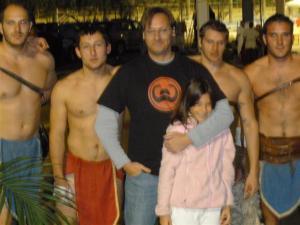
I blame Ryan for the blurriness of this photo…or perhaps my magnificence caused the camera to shake.
Here’s the Youtube channel of the company behind the show, where you can see videos of the action.
http://www.youtube.com/user/thrace23?feature=watch
Check ‘em out, LA!
-Hasta Pronto.


December 2, 2012
Happy 80th Birthday, Conan The Cimmerian
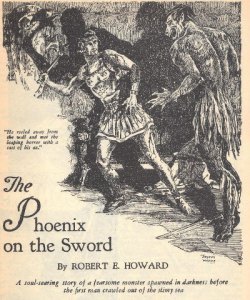 What do I know of cultured ways, the gilt, the craft and the lie?
What do I know of cultured ways, the gilt, the craft and the lie?
I, who was born in a naked land and bred in the open sky.
The subtle tongue, the sophist guile, they fail when the broadswords sing;
Rush in and die, dogs–I was a man before I was a king.
In December of 1932, Farnsworth “Plato” Wright, the editor of the seminal pulp fiction magazine Weird Tales ran a story by a virtually unknown West Texas writer named Robert E. Howard called “The Phoenix On The Sword.”
Set in the mythical Hyborian Age, it introduces a brooding, middle aged barbarian ruler called Conan of Cimmeria who has recently usurped the crown of the kingdom of Aquilonia, having led a revolt against the previous tyrant Numedides and strangling him to death as he sat on the throne. Conan is a dark giant of a man with scores of hard won victories behind him, but as we first find him, he’s confounded by the fickle nature of civilized men. His own people, once grateful to him for rescuing them from the cruelties of Numedides, have now built a statue to the modern king in the temple of the patron god Mitra, and denounce King Conan as a bloody minded foreignor and heathen (he pays nominal honor to a grim northern god called Crom, usually in the form of curses and oaths).
The rest of the story concerns the plan of four would-be conspirators, each with their own personal agendas, to assassinate Conan and retake the throne, and the plotting of a fifth character, a deposed sorcerror turned slave, seeking to regain his former powers, lost when a magic ring was stolen from him. Conan is forewarned of the attempt on his life by a long dead Merlin-like Aquilonian sage, who marks his sword with a phoenix sigil.
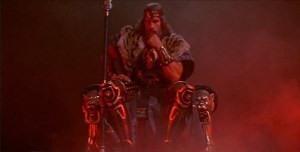 Waking and half-buckling on his armor, Conan meets his assassins and cuts them down to a man, then proceeds to kill a fanged gorilla demon summoned by the sorceror, who has regained his mystic ring.
Waking and half-buckling on his armor, Conan meets his assassins and cuts them down to a man, then proceeds to kill a fanged gorilla demon summoned by the sorceror, who has regained his mystic ring.
This is the first of seventeen stories Weird Tales published featuring the character most know as Conan The Barbarian.
Like a lot of people my age, I came to Conan through John Milius’ marvelous 80′s Arnold Schwarzenegger movie, justly famous for kickstarting (and in my opinion, forever dominating) the sword and sorcery genre in cinema. From the first thundering drumbeats of its unmatched Basil Poledouris score, to its savage crucifixion scene, Conan The Barbarian grabbed a hold of my 14 year old mind, just arrested my adolescent self, left me wanting more.
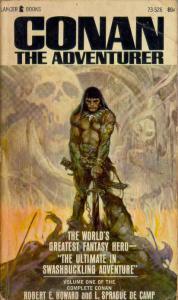 Having seen Robert E. Howard’s name in the opening titles, I sought out the original material at my local used bookstore, grabbing as many of the Lancer paperbacks with the incredible Frank Frazetta covers as I could find. This was in the days before the unadulterated Conan, when compiler and editor L. Sprague De Camp altered or finished a lot of Howard’s original stories to fit them into a chronology that included his own and other authors’ pastiches.
Having seen Robert E. Howard’s name in the opening titles, I sought out the original material at my local used bookstore, grabbing as many of the Lancer paperbacks with the incredible Frank Frazetta covers as I could find. This was in the days before the unadulterated Conan, when compiler and editor L. Sprague De Camp altered or finished a lot of Howard’s original stories to fit them into a chronology that included his own and other authors’ pastiches.
I was totally hooked, but even my inexperienced mind (this was before the internet, and I didn’t know a thing about Howard except what DeCamp told me in his forewards) could detect the difference between pure Howardian Conan and the imitators. I started looking for more stories with just Howard’s name, and that led me to Solomon Kane, King Kull, Bran Mak Morn, Cormac Mac Art, and Breckenridge Elkins.
But always, even to this day, I return to Conan, and Howard’s writing probably influences me more than anybody else I’ve ever read.
He’s like a prehistoric James Bond, but better than that. The character is an embodiment of what is primal in man, or in most men, anyway. I would say if you get a knot in your stomach when you think about politics, or the underhanded ways in which people deal with each other, if you dislike the shiftless infidelities modern society tends to deify on a daily basis, then Conan is for you. But I won’t bore you with my own why’s, they’re probably not much different from anyone else’s (or, as in all worthwhile art, your interpretation could be entirely different from mine and your appreciations different from my own, in which case I won’t color your opinions with my own).
I don’t need to tell you why I appreciate Conan. I’ll leave it to Howard’s writing.
My favorite Conan stories remain Black Colossus and The Hour of The Dragon, with The Frost Giant’s Daughter a close third.
Although Howard wrote the Conan stories out of chronological order (likening his process as relating the stories of the adventurer as he chose to recall them, not necessarily in the order they occured), in Black Colossus, I would say we see Conan in a period of transition. In his life he has been a savage barbarian, a worldly thief and bandit, a pirate, a soldier, and a mercenary. In this story we first see him in command of men as a general. This is his last step before becoming the king we will see in Phoenix On The Sword.
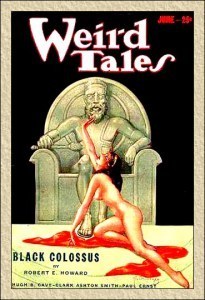 The gods have a hand in Conan’s destiny once again, when Princess Yasmela, the ruler of the kingdom of Khoraja, faced with the oncoming assault of a horde of desert warriors and monstrous creatures led by an ambitious three thousand year old wizard called Natohk, is instructed by the god Mitra (through the statue of Mitra in a temple as she prays in desperation) to place her armies in the command of the first man she meets on the street. Of course it turns out to be a drunken Conan, actually a paid soldier in the Khorajan army, who comically mistakes the princess’ intentions as the lewd advances of a wanton noblewoman.
The gods have a hand in Conan’s destiny once again, when Princess Yasmela, the ruler of the kingdom of Khoraja, faced with the oncoming assault of a horde of desert warriors and monstrous creatures led by an ambitious three thousand year old wizard called Natohk, is instructed by the god Mitra (through the statue of Mitra in a temple as she prays in desperation) to place her armies in the command of the first man she meets on the street. Of course it turns out to be a drunken Conan, actually a paid soldier in the Khorajan army, who comically mistakes the princess’ intentions as the lewd advances of a wanton noblewoman.
But soon he is convinced, and finds himself for the first time in command of an army, to his own secret delight and the utter disdain of his former superior officers, noblemen all.
Commanding the defense of a mountain pass as Natohk’s horde advances, Conan is faced first with the mutiny of a subordinate count and his knights, and deals with it it classic Conan fashion.
Conan sprang up with a curse. Thespides had swept in beside his men. They could hear his impassioned voice faintly, but his gesture toward the approaching horde was significant enough. In another instant five hundred lances dipped and the steel-clad company was thundering down the valley.
A young page came running from Yasmela’s pavilion, crying to Conan in a shrill, eager voice. “My lord, the princess asks why you do not follow and support Count Thespides?”
“Because I am not so great a fool as he,” grunted Conan, reseating himself on the boulder and beginning to gnaw a huge beef bone.
“You grow sober with authority,” quoth Amalric. “Such madness as that was always your particular joy.”
“Aye, when I had only my own life to consider,” answered Conan. “Now–what in hell–”
The horde had halted. From the extreme wing rushed a chariot, the naked charioteer lashing the steeds like a madman; the other occupant was a tall figure whose robe floated spectrally on the wind. He held in his arms a great vessel of gold and from it poured a thin stream that sparkled in the sunlight. Across the whole front of the desert horde the chariot swept, and behind its thundering wheels was left, like the wake behind a ship, a long thin powdery line that glittered in the sands like the phosphorescent track of a serpent.
“That’s Natohk!” swore Amalric. “What hellish seed is he sowing?”
The charging knights had not checked their headlong pace. Another fifty paces and they would crash into the uneven Kushite ranks, which stood motionless, spears lifted. Now the foremost knights had reached the thin line that glittered across the sands. They did not heed that crawling menace. But as the steel-shod hoofs of the horses struck it, it was as when steel strikes flint–but with more terrible result. A terrific explosion rocked the desert, which seemed to split apart along the strewn line with an awful burst of white flame.
In that instant the whole foremost line of the knights was seen enveloped in that flame, horses and steel-clad riders withering in the glare like insects in an open blaze. The next instant the rear ranks were piling up on their charred bodies. Unable to check their headlong velocity, rank after rank crashed into the ruins. With appalling suddenness the charge had turned into a shambles where armored figures died amid screaming, mangled horses.
Now the illusion of confusion vanished as the horde settled into orderly lines. The wild Kushites rushed into the shambles, spearing the wounded, bursting the helmets of the knights with stones and iron hammers. It was all over so quickly that the watchers on the slopes stood dazed; and again the horde moved forward, splitting to avoid the charred waste of corpses. From the hills went up a cry: “We fight not men but devils!”
On either ridge the hillmen wavered. One rushed toward the plateau, froth dripping from his beard.
“Flee, flee!” he slobbered. “Who can fight Natohk’s magic?”
With a snarl Conan bounded from his boulder and smote him with the beef bone; he dropped, blood starting from nose and mouth. Conan drew his sword, his eyes slits of blue bale-fire.
“Back to your posts!” he yelled. “Let another take a backward step and I’ll shear off his head! Fight, damn you!”
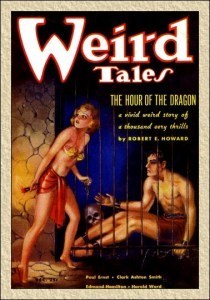 Hour Of The Dragon was Howard’s only full-length Conan novel. Set again during his time as ruler of Aquilonia, it concerns Conan’s long quest to regain his throne after being attacked and overthrown.
Hour Of The Dragon was Howard’s only full-length Conan novel. Set again during his time as ruler of Aquilonia, it concerns Conan’s long quest to regain his throne after being attacked and overthrown.
It contains one of my favorite passages. Having been prevented from leading his men into battle by sorcery, the Aquilonian army is smashed and the enemy closes on King Conan’s tent, where he has just risen groggily from his cot…
“Here comes the king of Nemedia with four companions and his squire,” quoth he. “He will accept your surrender, my fair lord–”
“Surrender the devil’s heart!” gritted the king.
He had forced himself up to a sitting posture. He swung his legs
painfully off the dais, and staggered upright, reeling drunkenly. The
squire ran to assist him, but Conan pushed him away.
“Give me that bow!” he gritted, indicating a longbow and quiver that
hung from a tent-pole.
“But Your Majesty!” cried the squire in great perturbation. “The
battle is lost! It were the part of majesty to yield with the dignity
becoming one of royal blood!”
“I have no royal blood,” ground Conan. “I am a barbarian and the son of a blacksmith.”
Wrenching away the bow and an arrow, he staggered toward the opening of
the pavilion. So formidable was his appearance, naked but for short
leather breeks and sleeveless shirt, open to reveal his great, hairy
chest, with his huge limbs and his blue eyes blazing under his tangled
black mane, that the squire shrank back, more afraid of his king than
of the whole Nemedian host.
Reeling on wide-braced legs Conan drunkenly tore the door-flap open
and staggered out under the canopy. The king of Nemedia and his
companions had dismounted, and they halted short, staring in wonder at
the apparition confronting them.
“Here I am, you jackals!” roared the Cimmerian. “I am the king! Death to you, dog-brothers!”
He jerked the arrow to its head and loosed, and the shaft feathered
itself in the breast of the knight who stood beside Tarascus. Conan
hurled the bow at the king of Nemedia.
“Curse my shaky hand! Come in and take me if you dare!”
Reeling backward on unsteady legs, he fell with his shoulders against
a tent-pole, and propped upright, he lifted his great sword with both
hands.
“By Mitra, it is the king!” swore Tarascus. He cast a swift look about
him, and laughed. “That other was a jackal in his harness! In, dogs,
and take his head!”
The three soldiers–men-at-arms wearing the emblem of the royal guards–
rushed at the king, and one felled the squire with a blow of a mace.
The other two fared less well. As the first rushed in, lifting his
sword, Conan met him with a sweeping stroke that severed mail-links
like cloth, and sheared the Nemedian’s arm and shoulder clean from his
body. His corpse, pitching backward, fell across his companion’s legs.
The man stumbled, and before he could recover, the great sword was
through him.
Conan wrenched out his steel with a racking gasp, and staggered back
against the tent-pole. His great limbs trembled, his chest heaved, and
sweat poured down his face and neck. But his eyes flamed with exultant
savagery and he panted: “Why do you stand afar off, dog of Belverus? I
can’t reach you; come in and die!”
And finally, in The Frost Giant’s Daughter, a very young Conan walks away, the last survivor of a bloody battle on a frozen northern plain between yellow haired Aesir and fierce Vanir tribesmen, and pursues a naked nymph across the blowing snow. It has one of the most memorable openings I’ve ever read (and is a piece of poetry when taken as a whole).
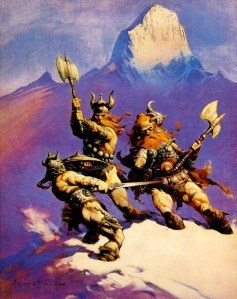 The clangor of the swords had died away, the shouting of the slaughter was hushed; silence lay on the red-stained snow. The bleak pale sun that glittered so blindingly from the ice-fields and the snow-covered plains struck sheens of silver from rent corselet and broken blade, where the dead lay as they had fallen. The nerveless hand yet gripped the broken hilt; helmeted heads back-drawn in the death-throes, tilted red beards and golden beards grimly upward, as if in last invocation to Ymir the frost-giant, god of a warrior race.
The clangor of the swords had died away, the shouting of the slaughter was hushed; silence lay on the red-stained snow. The bleak pale sun that glittered so blindingly from the ice-fields and the snow-covered plains struck sheens of silver from rent corselet and broken blade, where the dead lay as they had fallen. The nerveless hand yet gripped the broken hilt; helmeted heads back-drawn in the death-throes, tilted red beards and golden beards grimly upward, as if in last invocation to Ymir the frost-giant, god of a warrior race.
Across the red drifts and mail-clad forms, two figures glared at each other. In that utter desolation only they moved. The frosty sky was over them, the white illimitable plain around them, the dead men at their feet. Slowly through the corpses they came, as ghosts might come to a tryst through the shambles of a dead world. In the brooding silence they stood face to face.
Both were tall men, built like tigers. Their shields were gone, their corselets battered and dinted. Blood dried on their mail; their swords were stained red. Their horned helmets showed the marks of fierce strokes. One was beardless and black-maned. The locks and beard of the other were red as the blood on the sunlit snow.
“Man,” said he, “tell me your name, so that my brothers in Vanaheim may know who was the last of Wulfhere’s band to fall before the sword of Heimdul.”
“Not in Vanaheim,” growled the black-haired warrior, “but in Valhalla will you tell your brothers that you met Conan of Cimmeria.”
Happy birthday, Conan.
-Hasta pronto


November 26, 2012
DT Moviehouse Review: Back To The Future III
Time once more for my blog feature, DT Moviehouse Reviews, in which I make my way alphabetically through my 200+ DVD/Blu-Ray collection (you can see the list right here) and decide if each one was worth the money. Today I take a look at Back To The Future Part III.
(1990) Directed by Robert Zemeckis
Screenplay by Bob Gale
Tagline: They saved the best trip for last…but this time, they may have gone too far!
What it’s about:
Picking up moments after the end of Back To The Future Part II (when lightning struck the DeLorean sending Doc to parts unknown and leaving Marty stranded in 1955), a 70 year old Western Union telegram arrives for Marty from Doc, who has landed safely in 1885 but with an irreparably damaged time circuit. The telegram directs Marty and the 1955 Doc to a mine where the DeLorean has been stashed for 70 years, along with instructions on how to repair it using 1955 technology and get Marty home. But while fixing the time machine, ’55 Doc and Marty learn that 1885 Doc was murdered by Bull “Mad Dog” Tannon (Biff’s ancestor). Eschewing a return to 1985 to save his friend, Marty heads back to the Old West to rescue his friend.
As stated in my previous BTTF reviews, the entire Trilogy was a gift from a friend who upgraded to Blu-Ray (again, thanks, Ryan).
But would I have purchased BTTF Part III?
Well, admittedly, only had I purchased Part II.
It finishes out the series very nicely and it’s a western. Westerns are pizza for me. I’ll practically watch and find something to enjoy in just about every western ever made (except Jonah Hex…ew).
This is my favorite of the series after the first one. It’s a wonderful change of pace, putting Doc and Marty into a truly alien past setting, and even better, shifting the focus from Marty to Doc. If it suffers from anything, it’s that you sort of have to have seen Part II in order to fully appreciate everything that’s going on.
Believe it or not, I saw Part III in the theater without having seen Part II. It only took about a minute to acclimate to the plot, but I do realize I missed out on things like the reappearance of Flea’s character Needles towards the end, which retroactively establishes him as being partly responsible for 2015 Marty’s fall and subsequent failure in his nowhere job.
Marty grows up in this one to be sure. His realization that he doesn’t have to be bandied into confrontations (a lesson compounded by the fact that in 1885 a fight is to the death) leads to his altering the course of his own lackluster 2015 future (we presume).
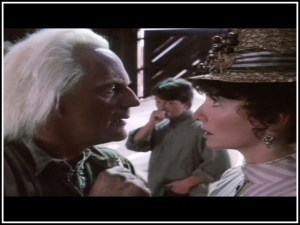 But as mentioned, most of the character focus is on Doc Brown. He is shown to be making out fine in 1885, an era he expressed a fondness for in 1955. Setting up a blacksmith shop, his barn is loaded with anachronistic inventions, from a ponderous refrigeration machine that makes one ice cube to a telescopic lens for his Winchester rifle. We learn about his love of futurist Jules Verne, a trait that opens up a dialogue with the wonderful Mary Steenburgen’s like minded schoolteacher Clara. Their relationship hearkens nicely back to a similar role she played earlier in her career as a woman in love with a time traveler, HG Wells himself, in Time After Time.
But as mentioned, most of the character focus is on Doc Brown. He is shown to be making out fine in 1885, an era he expressed a fondness for in 1955. Setting up a blacksmith shop, his barn is loaded with anachronistic inventions, from a ponderous refrigeration machine that makes one ice cube to a telescopic lens for his Winchester rifle. We learn about his love of futurist Jules Verne, a trait that opens up a dialogue with the wonderful Mary Steenburgen’s like minded schoolteacher Clara. Their relationship hearkens nicely back to a similar role she played earlier in her career as a woman in love with a time traveler, HG Wells himself, in Time After Time.
Their romance is the heart and the best element of BTTF Part III.
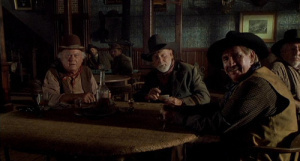
A table of western faces: Dub Taylor, Harry Carey Jr, and Pat Buttram
The movie is also full of nods to western fans. When confronted by Mad Dog, Marty tells them his name is Clint Eastwood hoping to intimidate them (and later employs the same method Eastwood’s Man With No Name in A Fistful of Dollars to ultimately defeat Mad Dog – as foreshadowed in BTTF Part II). Harry Carey Jr (3 Godfathers, The Searchers, etc), Pat Buttram (Petticoat Junction, The Gene Autry Show), and Dub Taylor (numerous westerns including The Wild Bunch and Gunsmoke) all share a table in Matt Clark (High Spade in The Outlaw Josey Wales)’s saloon, Burton Gilliam (Blazing Saddles) is a Colt pistol salesman, and Bill McKinney (The Outlaw Josey Wales, Bronco Billy) is a train engineer. In another nice touch, Mad Dog Tannon carries a riding quirt, bullying his underlings (and constantly saying ‘dude’) in a manner reminiscent of Lee Marvin in The Man Who Shot Liberty Valance.
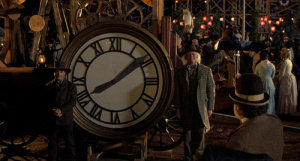 There are great self-referential touches too. Marty and Doc take a daguerreotype photo in front of the brand new clock face that will be set into the HillValley clock tower, to which their fates are inextricably tied. Doc apologizes once again for the crudity of a ridiculously complex scale model crafted to enact their plan for getting the DeLorean up to 88mph. Mad Dog mixes up his metaphors (“I’m gonna shoot you down like a duck.”) the same as Biff. Doc is shown to have created an 1880’s equivalent of the complex Rube Goldberg-like alarm and breakfast cooking machine shown in the opening scene of the first movie.
There are great self-referential touches too. Marty and Doc take a daguerreotype photo in front of the brand new clock face that will be set into the HillValley clock tower, to which their fates are inextricably tied. Doc apologizes once again for the crudity of a ridiculously complex scale model crafted to enact their plan for getting the DeLorean up to 88mph. Mad Dog mixes up his metaphors (“I’m gonna shoot you down like a duck.”) the same as Biff. Doc is shown to have created an 1880’s equivalent of the complex Rube Goldberg-like alarm and breakfast cooking machine shown in the opening scene of the first movie.
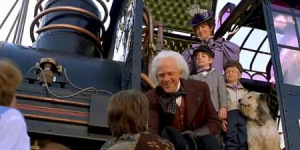 The unpleasantness of Part II is mostly gone here. BTTF III is a lighthearted, high spirited adventure and the shot of Doc with Clara and his kids Jules and Verne aboard the wonderfully designed steampunk time machine locomotive is a beautiful end to a great little series of movies. You can imagine the Doc and his family having continuing adventures throughout time once the credits roll.
The unpleasantness of Part II is mostly gone here. BTTF III is a lighthearted, high spirited adventure and the shot of Doc with Clara and his kids Jules and Verne aboard the wonderfully designed steampunk time machine locomotive is a beautiful end to a great little series of movies. You can imagine the Doc and his family having continuing adventures throughout time once the credits roll.
 But here’s a thought – if Marty’s maternal ancestor resembles Lorraine….what does that say about the McFly blood line? Eww…
But here’s a thought – if Marty’s maternal ancestor resembles Lorraine….what does that say about the McFly blood line? Eww…
Best bit of dialogue:
Heartbroken over his apparent loss of Clara, Doc retires all night to the saloon and waxes poetic over the wonders the of future to every available ear and a glass of whiskey (which he never even touches). When he tells the boys at the bar about the wonder of automobiles (“Where I come from, we don’t need horses,” a verbal reference to the previous “Where we’re going we don’t need roads.”), one of them asks -
Do people walk anymore? Do they run?
Doc: Of course we run. But for fun. For recreation.
Pat Buttram (in his hilarious, characteristic hound dog drawl): Run for fun? What the hell kinda fun is that?
Best scene:
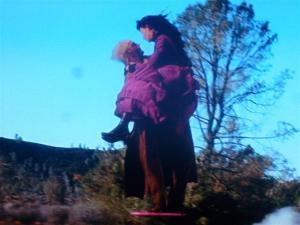 I really love the climactic sequence. In typical BTTF style everything requires precision timing (“Why do we always have to cut these things so damn close?” Marty declares at one point). The superheated locomotive engine must push the DeLorean up to 88mph to activate the flux capacitor and send Marty and Doc back to the future. Of course the track ends at about the 88mph mark and plunges into a ravine. Then Clara decides to pursue Doc and blunders aboard the doomed engine, forcing Doc to vacate the time machine to save her. At the last split second, Marty flips Doc the 2015 hoverboard, and Doc takes Clara in his arms. Marty’s last sight of them as the time circuits activate is of the two of them floating off safely as the locmotive hurtles into empty space.
I really love the climactic sequence. In typical BTTF style everything requires precision timing (“Why do we always have to cut these things so damn close?” Marty declares at one point). The superheated locomotive engine must push the DeLorean up to 88mph to activate the flux capacitor and send Marty and Doc back to the future. Of course the track ends at about the 88mph mark and plunges into a ravine. Then Clara decides to pursue Doc and blunders aboard the doomed engine, forcing Doc to vacate the time machine to save her. At the last split second, Marty flips Doc the 2015 hoverboard, and Doc takes Clara in his arms. Marty’s last sight of them as the time circuits activate is of the two of them floating off safely as the locmotive hurtles into empty space.
An exciting scene with a positive, lovely ending.
Would I Buy it Again? Yes
NEXT IN THE QUEUE: Bad Company


November 19, 2012
Reality Hopping With Greg Mitchell: Rift Jump
Today I’m giving some space to fellow author Greg Mitchell, author of The Coming Evil Trilogy. Specifically, we’re talking about his new Young Adult time travel/multiverse skipping adventure novel Rift Jump from Splashdown Books. I’m fascinated by the notion of multiple realities, as is evidenced when you get deeper along into Merkabah Rider.
From the back of the book:
“A sinister threat is growing in the void between realities, and teenager Michael Morrison has been recruited to stop it. Ripped from his own violent life, he is sent rift jumping to other worlds seeking out the agents of the Dark and putting them to an end by any means necessary. The love of his life, Sara, joins him as he battles Civil War spaceships, sea serpents, superpowered humans, and even his own duplicate from a parallel timeline.
But the darkness he fights is growing within him too, calling him to the same destiny as every other Michael from every other world. If he is to change his fate, he must learn to love, to forgive, to trust, and to let the man in the Stetson guide him to become the warrior of the Light he was always meant to be.”
What influenced you into wanting to write about a hero traversing multiverses?
I was in high school when I first came up with the idea of Rift Jump. I’ve never been the kind of writer who just imagines thousands of different story ideas. I’ve always wanted to create a concept or a character that I could get behind and one that could fit endless adventures. Back then, I was desperate to come up with my Big Idea. Michael Morrison was very much the product of my adolescence. He’s everything that I wasn’t—strong, fearless, street smart, confident with the ladies, etc. I really clung to him as an avatar for my teenage self. But I needed something for him to fight, and I couldn’t decide on a single mythology. Was it a mythology populated by super villains or monsters or aliens or criminals? All these years later I realize that I could have made a single story-world with all those types of characters, but back then I thought those different ideas were irreconcilable. Which led me to the idea of a multiverse. That opened up endless possibilities for the kinds of stories I could tell or the kinds of foes Michael could encounter. I was convinced that, that way, I would never get bored by settling on a single concept. Michael could fight vampires in one story, stop an alien invasion in the next, and then fight some Earth-grown terrorists. Not very inspired, mind you, just a way to amuse myself, really.
Did you make a conscious effort to create a young adult hero or a story geared towards young adults?
Again, when I started thinking about Rift Jump, I WAS a young adult, so I didn’t see anything unique about it. As I got older and decided I wanted to dust off the concept and write it “for real”, I never considered making Michael an adult. Being a teenager is such a singular experience and completely integral to Michael as a character and to my mindset when I first created him. So, rather than dodging the fact he was a teenager, I wanted to explore the subject matter with as much honesty as I could. In the story, he starts rift jumping when he’s twelve. That was always in the original idea. Looking back, that was really stupid, but, hey, I was fifteen, what did I know? But instead of changing it, I decided to break it down. What WOULD it be like for a 12-year-old to be on his own in a multiverse, toppling evil empires for the next five years? How terrifying would that be? How lonely? Add to that a journey through adolescence and all the conflicting and wild emotions that come with that. I drew a lot from my own experiences as a teenager and the insecurities I felt. I didn’t write about those emotions back in high school because the wounds were still being inflicted and it was too personal, but as a (mostly) well-adjusted thirty-something adult with a beautiful and supportive wife and two great kids, I felt safe enough to go back and face all those teenage demons in full truth. At times it was very raw returning to those days, but cathartic. The writing is a lot more honest than I was capable of when I was a kid. Rift Jump is fairly unflinching in its portrayal of being a scared, confused, angry teenager. I didn’t really envision myself writing for a younger audience, but now that it’s out, I certainly hope that young adults can read this and relate to it and realize they’re not alone in what they’re feeling—but also see something to aspire to. When you’re a teenager, you can’t always see past that, but there’s a whole world and a whole life beyond high school. But we can so easily screw that life up by the impulsive decisions we make in our youth. We have the power to choose who we are going to be: that’s the entire thrust of Rift Jump.
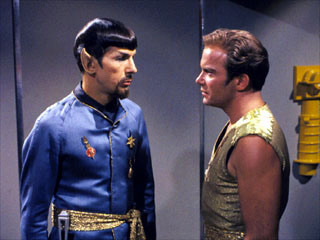 Do you believe in the possibility of multiple, concurrently existing realities or timelines? Now I ask this solely because your other series The Coming Evil has a definite Judeo-Christian influence and you yourself are a Christian – do you think such a belief could be reconciled with faith in intelligent design in the universe?
Do you believe in the possibility of multiple, concurrently existing realities or timelines? Now I ask this solely because your other series The Coming Evil has a definite Judeo-Christian influence and you yourself are a Christian – do you think such a belief could be reconciled with faith in intelligent design in the universe?
Well, I don’t know if I’d stake my life on it, but I think it could be possible. And I certainly feel God would still be at the center of it all. I have a very big view of God. He’s infinite. Who knows what He has set up or what He’s maintaining right now. I do believe that God exists outside of space and time, which means He is in every moment at once—past, present, future. Does that mean He could also be existing in dimensions parallel to our own at the same time? I think He absolutely could. He’s God.
That’s one of the concepts I wanted to explore in the book. When I began writing Rift Jump, some of the questions I asked myself up front were, if there are multiple realities, are there multiple Gods? Multiple versions of heaven and hell? Ultimately I decided on God being a singular entity that exists outside of all realities. Likewise, there is only one heaven, one hell, one set of angels and demons, if you will. That’s where the concept came from for the “In-Between”, the space between the planes of reality where all the “supernatural” stuff exists, completely unaffected by the crude material world of the multiverse. Ultimately in my concept, the multiverse boils down to a construct of Choice. In the Bible, God gave us freewill to choose—so we have the option of following Him or rejecting Him, of being righteous or being wicked. So, just as you have one reality where you chose good things, there’s another reality where you chose bad things. That’s choice. In Rift Jump, God is present in all realities with full knowledge of all possibilities and outcomes—just as I feel would be the case if parallel realities actually exist.  The question then becomes, does one reality have to exist for the other to, as well? Can you REALLY “choose good” if there’s only one reality—one choice? Does there need to be a reality where you chose wrongly, in order for there to be a reality where you chose right? That was my thinking going into Rift Jump. As to whether or not I believe all of that is a factor in our real world—I wouldn’t totally count it out, but that’s above my pay grade. I strive to make good choices that honor God and make the most out of my particular plane of reality—but I do often wonder about that other Greg who might exist somewhere in the multiverse, who chose to go down all the wrong paths in life. I’m curious as to what his life might be like now. I don’t think I would want to meet that Greg in a dark alley.
The question then becomes, does one reality have to exist for the other to, as well? Can you REALLY “choose good” if there’s only one reality—one choice? Does there need to be a reality where you chose wrongly, in order for there to be a reality where you chose right? That was my thinking going into Rift Jump. As to whether or not I believe all of that is a factor in our real world—I wouldn’t totally count it out, but that’s above my pay grade. I strive to make good choices that honor God and make the most out of my particular plane of reality—but I do often wonder about that other Greg who might exist somewhere in the multiverse, who chose to go down all the wrong paths in life. I’m curious as to what his life might be like now. I don’t think I would want to meet that Greg in a dark alley.
Is there a possibility that Rift Jump will continue as a series, or is it intended as a standalone effort?
I’m working on a follow-up to Rift Jump right now that serves as a companion piece to this book. Rift Jump is Michael’s story, but its follow-up will mostly be about his true love Sara and the changes she goes through as a result of the things that happen in this book. Young love is a powerful thing, but even the Bible warns against waking it before it so desires “for love is as strong as death, and its jealously as unyielding as the grave.” That’s what the follow-up is about. It ties up all the loose ends from the first book into a pretty epic, tear-jerking conclusion. They make a nice set. After that, I don’t have any more planned, but in a multiverse of infinite possibilities, anything can happen, I suppose.
Rift Jump is available on Amazon/Kindle and all other digital formats on Smashwords. Here’s a link to the publisher’s site, which includes links to all formats:
http://www.splashdownbooks.com/darkwater/rift-jump
Hasta pronto!


November 16, 2012
Terovolas Available Now From JournalStone
Available now everywhere from JournalStone Publishing, my latest book, Terovolas being an excerpt from The Van Helsing Papers, and covering Abraham Van Helsing’s incredible 1891 sojourn in Texas following the events portrayed in Bram Stoker’s Dracula.
Read an excerpt here -
http://emerdelac.wordpress.com/2012/09/19/terovolas-van-helsing-in-texas-giveaway-on-goodreads/
Pick it up on Amazon here -
Or directly from the publisher here -
http://journal-store.com/fiction/terovolas/
Head to Goodreads and enter for a chance to win one of ten paperback copies.
Got Paypal and want a signed copy? Drop me an email at emerdelacATgmailDOTcom for pricing.
Lastly, starting now, leave a comment below. At midnight on Thanksgiving Day, November 22nd, I’ll pick a random winner to receive a free signed copy.
Good luck!


November 14, 2012
The Next Big Thing
Author Weston Ochse (whose supernatural military thriller Seal Team 666, already optioned for a movie, is due to hit the stands running next month) tagged me in something called The Next Big Thing, in which authors answer questions about their forthcoming works and then tag five other writers they’d like you to know about.
So here are my answers.
1) What is the working title of your next book?
Terovolas.
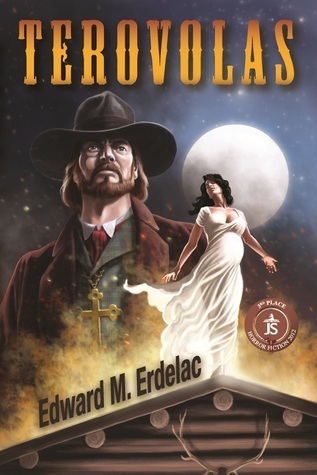 2) Where did the idea come from for the book?
2) Where did the idea come from for the book?
In 1997 I came across a collection of papers in a sealed box on a shelf in the basement of the University of Chicago’s Regenstein Library. I call the documents The Van Helsing Papers. They were a series of primary source accounts, including the personal journal of the actual Professor Abraham Van Helsing, translated from Dutch by Dr. John Seward. I chose to collect the events of 1891 immediately following those depicted in Bram Stoker’s Dracula as Terovolas.
3) What genre does your book fall under?
Though a nonfictional account, it’s being presented as fiction, in which case I guess you’d call it a weird western horror/mystery.
 4) What actors would you choose to play the part of your characters in a movie rendition?
4) What actors would you choose to play the part of your characters in a movie rendition?
I think Francis Ford Coppola’s Bram Stoker’s Dracula infected me with the notion that Anthony Hopkins is the perfect Abraham Van Helsing. Alexander Skarsgard might make a good Sigmund Skoll. I could see Michael Shannon as Coleman Morris, Robert Duvall as Aurelius Firebaugh, Carrie Ann Moss as Callisto Terovolas, and Sam Rockwell as Alvin Crooker.
 5) What is the one-sentence synopsis of your book?
5) What is the one-sentence synopsis of your book?
Recently released from Purfleet Asylum after suffering a nervous breakdown stemming from the events of Dracula, Professor Abraham Van Helsing bears the remains of Quincey Morris back to Texas and winds up tangling once more with the supernatural, doubting his own sanity in the process.
6) Will your book be self-published or represented by an agency?
Terovolas is being put out by JournalStone Publishing.
7) How long did it take you to write the first draft of the manuscript?
I compiled it in about three or four months.
8) What other books would you compare this story to within your genre?
Eaters Of The Dead by Michael Chrichton, Nicholas Meyers’ The Seven Percent Solution, The Memoirs Of Wild Bill Hickock by Richard Matheson, and of course Bram Stoker’s Dracula.
9) Who or what inspired you to write this book?
When I learned the truth about Van Helsing, I wanted to present this information to the world. I think in a lot of media, Van Helsing is portrayed as something of a fanatic. My research has led me to believe that nothing could be further from the truth. He’s no more a fanatic than he is exclusively a vampire hunter. The real Van Helsing was a man who walked the line between science and faith, reasoning and superstition, really the best of both worlds. He had an amazing career of which the account of Dracula for which he is most remembered, is only a small part. In popular modern fiction he’s most often depicted in a negative light, whereas Dracula has conversely been lionized. This is a travesty that I felt needed rectifying.
10) What else about the book might pique the reader’s interest?
It’s the first of a series of true accounts of the further adventures of Abraham Van Helsing, beginning with a sojourn in Texas in which he encounters shapechangers, cultists, and outlaws. If you need more than that, I don’t know what to tell you.
So next Wednesday, visit the following writer’s blogs to read about what they’ve got in the works, and why I chose them as The Next Big Thing…


November 9, 2012
Man Talk: The James Bond Title Sequences Over At Hasslein Books
In anticipation of Skyfall, I’m writing a three part article on the James Bond title sequences for Rich Handley’s Hasslein Books, purveyors of fine unofficial movie tie-ins like Timeline Of The Planet Of The Apes, A Matter Of Time: The Unofficial Back To The Future Lexicon, and the forthcoming James Bond Lexicon.
Back in my film school days I did a paper on the James Bond title sequences as a genre of short film, replete with its own tropes and recurring motiffs. I’m a tremendous James Bond aficionado (because he’s too cool to use the term ‘fan’ or ‘geek’), both the Ian Fleming novels and the films, and I had a lot of fun revisiting these.
Go check out part I, From Dr. No to On Her Majesty’s Secret Service here, and watch for II and III at Hasslein Books’ blog -
http://hassleinbooks.blogspot.com/2012/11/titles-bond-titles-part-onefeaturing.html



